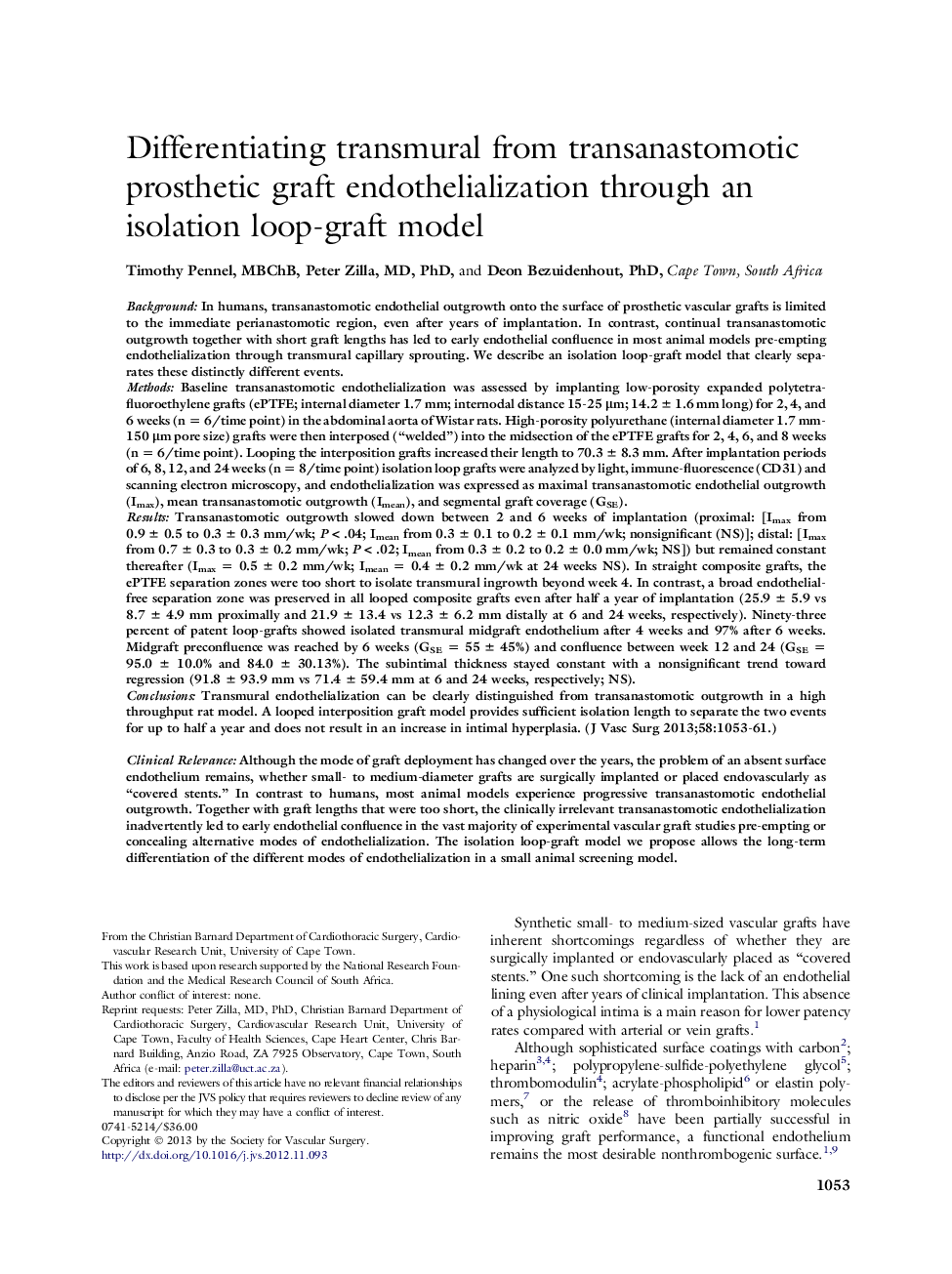| کد مقاله | کد نشریه | سال انتشار | مقاله انگلیسی | نسخه تمام متن |
|---|---|---|---|---|
| 2989042 | 1179833 | 2013 | 9 صفحه PDF | دانلود رایگان |

BackgroundIn humans, transanastomotic endothelial outgrowth onto the surface of prosthetic vascular grafts is limited to the immediate perianastomotic region, even after years of implantation. In contrast, continual transanastomotic outgrowth together with short graft lengths has led to early endothelial confluence in most animal models pre-empting endothelialization through transmural capillary sprouting. We describe an isolation loop-graft model that clearly separates these distinctly different events.MethodsBaseline transanastomotic endothelialization was assessed by implanting low-porosity expanded polytetrafluoroethylene grafts (ePTFE; internal diameter 1.7 mm; internodal distance 15-25 μm; 14.2 ± 1.6 mm long) for 2, 4, and 6 weeks (n = 6/time point) in the abdominal aorta of Wistar rats. High-porosity polyurethane (internal diameter 1.7 mm-150 μm pore size) grafts were then interposed (“welded”) into the midsection of the ePTFE grafts for 2, 4, 6, and 8 weeks (n = 6/time point). Looping the interposition grafts increased their length to 70.3 ± 8.3 mm. After implantation periods of 6, 8, 12, and 24 weeks (n = 8/time point) isolation loop grafts were analyzed by light, immune-fluorescence (CD31) and scanning electron microscopy, and endothelialization was expressed as maximal transanastomotic endothelial outgrowth (Imax), mean transanastomotic outgrowth (Imean), and segmental graft coverage (GSE).ResultsTransanastomotic outgrowth slowed down between 2 and 6 weeks of implantation (proximal: [Imax from 0.9 ± 0.5 to 0.3 ± 0.3 mm/wk; P < .04; Imean from 0.3 ± 0.1 to 0.2 ± 0.1 mm/wk; nonsignificant (NS)]; distal: [Imax from 0.7 ± 0.3 to 0.3 ± 0.2 mm/wk; P < .02; Imean from 0.3 ± 0.2 to 0.2 ± 0.0 mm/wk; NS]) but remained constant thereafter (Imax = 0.5 ± 0.2 mm/wk; Imean = 0.4 ± 0.2 mm/wk at 24 weeks NS). In straight composite grafts, the ePTFE separation zones were too short to isolate transmural ingrowth beyond week 4. In contrast, a broad endothelial-free separation zone was preserved in all looped composite grafts even after half a year of implantation (25.9 ± 5.9 vs 8.7 ± 4.9 mm proximally and 21.9 ± 13.4 vs 12.3 ± 6.2 mm distally at 6 and 24 weeks, respectively). Ninety-three percent of patent loop-grafts showed isolated transmural midgraft endothelium after 4 weeks and 97% after 6 weeks. Midgraft preconfluence was reached by 6 weeks (GSE = 55 ± 45%) and confluence between week 12 and 24 (GSE = 95.0 ± 10.0% and 84.0 ± 30.13%). The subintimal thickness stayed constant with a nonsignificant trend toward regression (91.8 ± 93.9 mm vs 71.4 ± 59.4 mm at 6 and 24 weeks, respectively; NS).ConclusionsTransmural endothelialization can be clearly distinguished from transanastomotic outgrowth in a high throughput rat model. A looped interposition graft model provides sufficient isolation length to separate the two events for up to half a year and does not result in an increase in intimal hyperplasia.
Clinical RelevanceAlthough the mode of graft deployment has changed over the years, the problem of an absent surface endothelium remains, whether small- to medium-diameter grafts are surgically implanted or placed endovascularly as “covered stents.” In contrast to humans, most animal models experience progressive transanastomotic endothelial outgrowth. Together with graft lengths that were too short, the clinically irrelevant transanastomotic endothelialization inadvertently led to early endothelial confluence in the vast majority of experimental vascular graft studies pre-empting or concealing alternative modes of endothelialization. The isolation loop-graft model we propose allows the long-term differentiation of the different modes of endothelialization in a small animal screening model.
Journal: Journal of Vascular Surgery - Volume 58, Issue 4, October 2013, Pages 1053–1061